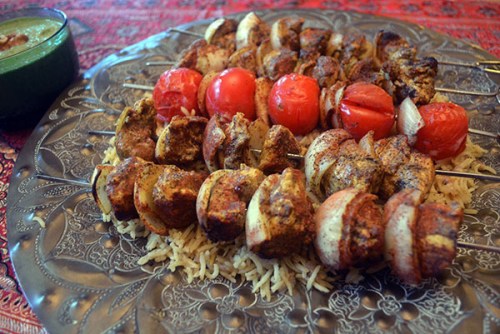
Chicken kebabs with cinnamon and black pepper with a side of Afghan cilantro sauce. (Photo by Mike Peters/China Daily)
Laura Kelley is a trained scientist, but cuisine is her true passion. The enthusiastic foodie tells Mike Peters why she wrote a book based on her culinary adventures across the Silk Road.
She's a scientist - a biologist - and a public-health researcher. But ask Laura Kelley what her driving passion is, and the answer may surprise you.
"Baking bread with Kazak women in primitive ovens, that's what I love doing," says the author of The Silk Road Gourmet cookbook and a culinary website and blog based on her travels.
We're chatting via Skype, and even the remote technology can't hide the fact that Kelley is thrilled to be grilled about what she's doing and why.
"I've never been a writer - just reports and such," she confides, "so the book was just a brave new thing."
How did a biologist who traveled the world on decontamination missions become such a foodie?
"It's not like I accidentally wandered into it," she says. "I was born into an old Italian family - we lived in the kitchen. My mother always wanted to feed everybody - if the TV repairman came or 30 relatives, it was all the same: 12 courses and eating all day, meals sort of like you see at Chinese New Year."
One inspiration: The Viking Cookbook. "That was like combining archaeology, a cooking expert and a sommelier", noting that the reconstructed cooking for those ancient seafaring Danes was "based on food hints in sagas, etc". Fascinating, she concedes, but "the best analytical evidence is based on real evidence".
The Silk Road Gourmet, she says, is really about pattern recognition, recalling her many travels in her public-health career, which began in Thailand working for American Field Service. "I'm trained in pathology, in reading slides to identify types. I saw patterns come together in food."
One might argue, she writes in The Silk Road Gourmet, that the masalas of western and southern Asia, from Tibet to India, are simply the five-spice powders of the East. She lays out the evidence, first a full-page table of seasoning mixtures used in the region, then simple comparisons of ingredients.
"Georgians use a combination of coriander, walnuts and lemon juice for meats," she tells China Daily. "Afghans will change the last ingredient to vinegar and use it on fowl. Indians may change the last item again and use the mixture on fish."
"I started the website to make those kinds of food connections," she says.
"For example, pomegranates - the use of which began in Iran in antiquity - are now common ingredients from Georgia to the far northwest to Uzbekistan and Kazakhstan in the northeast. Examining the political history of the area, we see that successive Persian empires ruled all of these areas at one time or another - often dominating the cultural landscape for hundreds or even thousands of years."
Identifying markers are shared, she adds.
"The Silk Road was an incredible engine of globalization - we have nothing like it today," she says. "Well before the Yuan Dynasty (1271-1368), when the Mongols came to China, people were going all over, traveling, trading."
















































